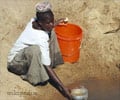Causes of Shigellosis
Shigellosis spreads by ingesting the bacteria on contaminated fingers, food or water.
The number of Shigella bacteria required to cause an infection is small. As little as 10 to 100 organisms can cause dysentery.
Shigellosis is often found to occur in crowded places such as day care centers, nursing homes, refugee camps, and other places where the sanitation is poor. Poor hygiene or eating contaminated food may cause this illness.
"This is not surprising: (Day care) exposes babies and toddlers to large numbers of biological strangers, many of whom are not toilet trained and who drool, making day care a breeding ground for infectious disease." - 'Day Careless', by Maggie Gallagher, a Nationl Review, 26-Jan-1998
- Shigellosis mostly occurs among toddlers or young children who are not completely toilet trained.
- School or playmates of infected children and also their family members are also at greater risk of developing the infection.
- Infected food handlers, who fail to wash their hands adequately with soap after using the toilet, are likely to contaminate the food that they handle, thus spreading the infection.
- Vegetables, harvested from a field contaminated with sewage, also help to spread the infection.
- Shigellosis can result from drinking or swimming in contaminated water. Water bodies may get contaminated with sewage and any one who swallows the contaminated waters while swimming, or drinks it directly, is likely to become affected.
- Feces infected with Shigella bacteria become the breeding ground of flies, which then goes on to contaminate the food.
- Sex, especially oral or anal sex is likely to spread the disease. Homosexual men have a greater chance of developing shigellosis.
Every year, approximately, 18,000 cases of shigellosis are reported in the United States alone, where it is more widespread in the summer months than in winter.











